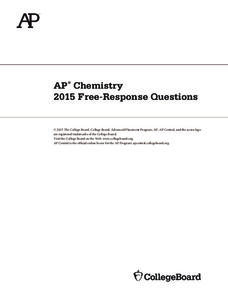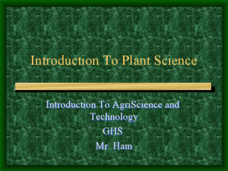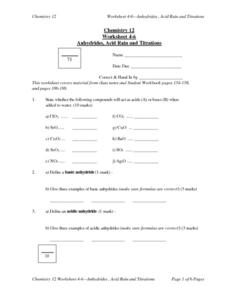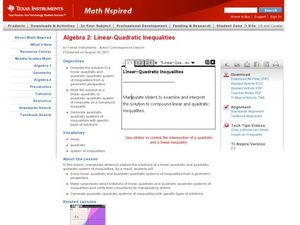Curated OER
Naming Compounds
In this naming compounds instructional activity, students are given a chart to determine if the compound they are naming is ionic, covalent or polyatomic. Students practice identifying and naming ionic, covalent and polyatomic compounds....
Curated OER
Inequalitities Mixed Review
Students solve inequalities and graph it on a number line. For this algebra lesson, students rewrite word problems into algebraic equations and graph it using compound inequalities.
Curated OER
IUPAC Rules for Naming Compounds with Functional Groups
In this naming compounds with functional groups worksheet, students read about using the IUPAC rules for naming these compounds and they draw structures for 3 -carbon, 2-carbon and 4-carbon molecules and give the names for each.
Curated OER
Naming Compounds
In this compounds worksheet, students compare ionic, covalent, and polyatomic compounds and give examples of each type. This worksheet has 1 matching, 3 problem solving, and 4 short answer questions.
Curated OER
Hydrocarbons
Making models is always memorable. In this activity, physical science starters examine the structure of hydrocarbons using marshmallows, raisins, and toothpicks. They even act as atoms themselves and link arms to represent covalent...
CK-12 Foundation
Additive and Multiplicative Rules for Probability: Red Dress? Blue Dress? Both!
The sum of the parts is greater than the whole. An interactive uses a Venn-like model to show the percentage of females from a survey that have a blue dress, a red dress, or both. The pupils determine the numbers in each category...
University of Georgia
Antacid and Uncle Heartburn
Household materials can be used for more than cleaning! In this collaborative experiment, emerging chemists use products such as vinegar and liquid antacid to explore chemical reactions that commonly occur in the human body.
College Board
2015 AP® Chemistry Free-Response Questions
More than 80,000 scholars earned college credit for Chemistry with the AP exam in 2015. The College Board released the free-response questions covering topics, including moles, that often confuse scholars. They also released example...
Curated OER
Introduction to Plant Science
Although the formatting is less than perfect and some of the pictures are blurry, the information in this presentation on plants is pertinent. Viewers will be able to compare and contrast plants with animals. They will learn about...
Curated OER
Using the Stock System
In this compounds worksheet, students learn the rules for naming compounds, the stock system. Students apply these rules by writing the names or formulas for the 20 given compounds.
Curated OER
Anhydrides, Acid Rain and Titrations
In this chemical compounds worksheet, students determine is compounds will act as acids or bases when added to water. Students compare basic, acidic, and amphoteric anhydrides. This worksheet has 15 fill in the blank, 2 short answer...
Curated OER
Sentence (Structure) Recognition Practice
In this sentence clauses worksheet, sixth and seventh graders read ten sentences and write down whether the sentence is: simple, compound, complex or compound-complex.
Curated OER
What is a Compound Machine?
In this compound machine worksheet, students review what simple machines are put together to make compound machines. This worksheet has 5 fill in the blank and 2 short answer questions.
Curated OER
Combining Elements to Form a Compound
Students explore elements and compounds. In this lesson about elements and compounds, students will do an experiment. Students work in groups of 2-3 as they complete two separate activities. Students understand how two elements combine...
Curated OER
Naming Binary Covalent Compounds
In this compounds instructional activity, students read how to name binary covalent compounds and then practice by naming 10 binary covalent compounds.
Curated OER
Writing Formulas for Ionic Compounds with Complex Ions
In this writing formulas activity, students write the formulas for 15 complex ionic compounds and name their anions and cations. Students must balance the charges on the ions and determine the formula.
Curated OER
Linear-Quadratic Inequalities
High schoolers graph linear and quadratic functions. In this algebra lesson, students create graph with specific coordinate points. They use the Ti to visualise and differentiate between the two functions.
Curated OER
Algebra Word Problems
In this inequality word problem worksheet, students solve ten word problems related to algebra and inequalities. They first determine how many pounds of cheese it would take to make a specific amount of grated cheese topping. Students...
Curated OER
Chemical Compounds
In this chemical compounds instructional activity, learners determine the mechanism for chemical reactions, predict the products for given reactions, and write in the structure for compounds. This instructional activity has 5 problems to...
BW Walch
Creating and Graphing Exponential Equations
Frequently found in biology and economic application problems, exponential equations show up as stars in this introductory presentation. Taking no background or knowledge of exponentials for granted, the slides walk learners through the...
Practical Money Skills
Saving and Investing
You have to have money to make money, especially in the world of banking and investments. High schoolers learn about interest rates, saving and investment options, and ways to stay aware of their money's security and earning ability with...
Curated OER
Elements, Compounds, and Mixtures
In this matter worksheet, students review the three forms of matter by reading a poem and completing 1 matching and 5 short answer questions.
Curated OER
Subjects and Predicates
From simple subjects to compound predicates, this PowerPoint is a great tool for teaching the two parts of a sentence: subject and predicate. There are thirty-one colorful and interactive slides in this presentation which includes brief...
Curated OER
Naming Acids
In this naming acids worksheet, students are given a chart with polyatomic ions and acid names with oxidation states, prefixes and suffixes. They use the chart to help name the eighteen given acids.

























